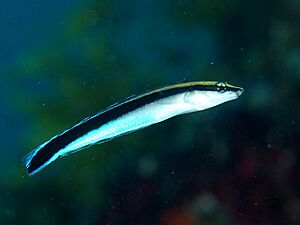False cleanerfish facts for kids
Quick facts for kids False cleanerfish |
|
|---|---|
 |
|
| Conservation status | |
| Scientific classification |
The false cleanerfish (Aspidontus taeniatus) is a clever little fish that lives in coral reefs. It's a type of combtooth blenny. This fish is an amazing mimic! It copies both the special "dance" and the look of another fish. That fish is the bluestreak cleaner wrasse (Labroides dimidiatus).
The bluestreak cleaner wrasse is a helpful cleaner wrasse. It eats tiny parasites off bigger fish. The false cleanerfish looks like the cleaner wrasse to avoid being eaten. Sometimes, it even tries to bite the fins of other fish instead of cleaning them! Young fish are often tricked. But older fish might remember being bitten and stay away from the false cleanerfish.
You can find this fish in coral reef homes across the Indo-Pacific ocean.
Contents
How Does it Mimic?
Looking Like a Cleaner Wrasse
The false cleanerfish mostly lives near cleaning stations. These are places where the bluestreak cleaner wrasse (Labroides dimidiatus) helps other fish. The false cleanerfish is usually seen close to one or more real cleaner wrasses.
Since it lives in the same areas, the false cleanerfish copies how the cleaner wrasse looks. It also sometimes copies its behavior. The false cleanerfish usually has the same black stripe and blue body as the cleaner wrasse. It also has a similar body shape. But some false cleanerfish have been seen copying other reef fish. They can even copy cleaner wrasses with unusual colors in their area.
Young false cleanerfish look just like young cleaner wrasses. They have a black body and a blue stripe on their back. As they grow, they keep matching the colors of cleaner wrasses their size. Scientists are not sure if the false cleanerfish keeps one color pattern. Or if it changes its colors to match cleaner wrasses nearby.
There is one main difference in how they look. The false cleanerfish has a mouth that points downwards. The cleaner wrasse's mouth is at the front of its head. Also, the false cleanerfish has small teeth on its upper jaw. It also has huge teeth that stick out from its lower jaw. These big teeth fit into special spots on the roof of its mouth.
Tricky "Cheating" Behavior
The false cleanerfish has been seen doing the special "dance" of the bluestreak cleaner wrasse. It spreads its tail fin and moves its back end up and down. When it does this, other fish pose for it, just like they do for the real cleaner wrasse.
But sometimes, the false cleanerfish doesn't eat tiny parasites like the cleaner wrasse. Instead, it will attack and try to bite off pieces of fin from the fish. This trick works best with young fish. Older fish seem to remember being attacked. They might avoid or even attack the false cleanerfish. This shows that adult fish can often tell the difference between the real cleaner wrasse and the false one.
Why Does it Mimic?
Even though the false cleanerfish looks and swims like the cleaner wrasse, it doesn't "cheat" as often as people first thought. Scientists have looked inside false cleanerfish stomachs. They found mostly fish eggs and parts of tube worms. Only a small amount was fish fins or parasites. The real cleaner wrasse mostly eats parasites. Also, false cleanerfish only attack posing fish about 20% of the time.
The main reason the false cleanerfish mimics the cleaner wrasse is probably not to bite other fish. It's more likely to avoid being eaten by bigger fish. Many fish don't eat the real cleaner wrasse. For example, groupers raised in tanks don't attack cleaner wrasses. But they eat other non-cleaner fish they see.
If the false cleanerfish cheated too much, it would cause problems. Other fish would learn to avoid the cleaning stations. This would hurt the real cleaner wrasse and its helpful cleaning service.
However, how much they "cheat" can be different in different places. In the Red Sea and the Great Barrier Reef, false cleanerfish mostly ate tube worms. But in French Polynesia and Indonesia, especially young false cleanerfish, ate more fish tissue.
The way the false cleanerfish has evolved to look like the cleaner wrasse shows something important. It shows that fish that don't attack their cleaners are more likely to survive. It also supports the idea that helpful behaviors can evolve between different species.


